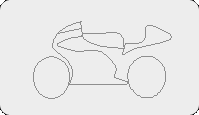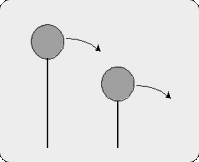|
TECHNICAL INFORMATION
SUSPENSION SETTING VOL.1
CBR600RR / CBR600F4I /
CBR1000RR / RS125R / RS250R


| •Important items in proceeding suspension settings
Road holding feel - stability - turning capability - lightness
|
| |
What you should note in proceeding suspension settings is that road holding feel and stability are in some sense incompatible with turning capability and lightness. For these reasons, giving priority to stability very much will result in better riding comfort, but slow in time settings. They should be well balanced for the best settings.
If four items above are well balanced, good times will result. |
| |
| Initial setting |
| The standard settings (described in the manual) are intended for the public. Accordingly, they do not suit particular rider's physique or riding style and you may feel difficulties in driving depending on course layouts. First, sinkage associated with riding load of 1G and suspension stroke after running should be determined, and then from these data spring stiffness (rate/initial) suited for riders should be identified. |
| |
| 1G setting |
| |
Riding 1G sinkage refers to front and rear suspension strokes given when a equipped rider rides on a machine and places his/her arms on the handle with the body slightly slanting to the front. Followings are measurements of this stroke.
| A) |
Measure the unloaded machine stroke. |
| B) |
Measure the stroke given when an equipped rider rides on a machine and places his/her arms on the handle with the body slightly slanting to the front. If the value A) minus the value B) is 10 to 20mm, it is acceptable. |
|
|
| |
|
|
| Checking by actually running |
| Basic body position |
| |
The position at the basic (static) state, including slanting forward or rearward, will largely control the machine characteristics.
1)Characteristics by body positions
|
|
| |
| •Flat position |
|
|
 |
|
This is the standard position.
There is no specialized characteristics, having well balanced overall specifications.
However, it may have a problem in controlling the machine depending upon course layouts or riding style. |
| |
| •Slanting forward position |
|
|
 |
|
In this position, the front has a larger load distribution. It provides a good turning capability, but, when at extremely slanted, you have a difficulty in controlling when loads are applied to the front during braking.
Unless loads to the rear are actively controlled, the rear tires may be slippery. |
| |
| •Slanting rearward position |
|
|
 |
|
The position of slanting rearward tends to provide dullness in approaching a corner although it gives stability.
It is effective against excessive loads to the front on descending corners. However, since it will result in degraded turning ability (especially for throttle on), and extremely rearward slanting position will cause under-steering at a corner, resulting in worse lap time. |
| |
| •High position |
|
|
 |
|
High position at both the front and rear improves turning capability, but may provide unstable factors including fore-and-aft pitching.
It gives slightly heavy falling feel at the beginning of falling, and when falling begins, it causes more and more falling force. |
| |
| •Low position |
|
|
 |
|
Low position at both the front and the rear degrades turning capability opposed to the high position, but allows you to easily make a chance to fall, providing light banking feel. |
| |
 |
|
The figure to the left helps understand the characteristics caused by changing height, showing two rods, with weights installed at the tip, are well balanced on your palm.
In this figure, the longer rod (means a high position) has slower speed in beginning to fall, which allows you to easily take a balance, but when falling, has more and more speeds and force.
The shorter rod (low position) has higher speeds when beginning to fall. |
|
|
| |
|
|
| |
2)Ride height adjustment setting flow chart
| •Insufficient turning capability |
| Symptom |
|
Degraded turning capability during cornering |
| |
 |
|
| Cause |
|
Position slants rearward, causing insufficient caster angles |
| |
 |
|
| Counter-measure |
|
Increase front projection and heighten rear height to increase caster angles |
| •Steering ability |
| Symptom |
|
When cornering during braking, the front steers inner. |
| |
 |
|
| Cause |
|
Excessive front load. Too high caster angles |
| |
 |
|
| Counter-measure |
|
Reduce front projection and lower rear vehicle height to reduce caster |
| •Shaky handle |
| Symptom |
|
Handle shakes during rising from a corner. |
| |
 |
|
| Cause |
|
Insufficient front load |
| |
 |
|
| Counter-measure |
|
Increase front projection and rear vehicle height to move loads |
|
|
| |
|
|
| |
 |
 |
 |
 |
Advice
Adjustment should always be made in unit of mm (2 to 3mm). Setting changes should not be made at two or more locations for the same purpose (e.g. for both increasing projection and heightening rear vehicle height) |
 |
 |
 |
 |
|
|
| |
|
|
| |
Note
Not only vehicle height but also suspension stroke will largely influence the symptoms above.
When complaints are found, settings should be made taking into account overall positions including strokes.
|
|
| |
| Other notes on suspension settings |
| |
| • |
Front suspension inner pressure adjustment |
| |
Front suspension, when stroked repeatedly, will cause suspension inner air amount to be changed, resulting in changed inner pressure. For this reason, since settings are changing every time you ride on a machine, the inner pressure should be periodically adjusted. |
| |
| • |
Settings associated with ambient temperature changes |
| |
Changes in ambient temperatures will cause suspension inner oil viscosity to be largely changed, needing resetting.
Ambient temperatures at 5°C or less in mid-winter will harden inner oil, while ambient temperatures at 30°C or more in mid-summer will largely lower oil viscosity, resulting in a problem with damping. |
| |
| • |
Suspension split-tightening |
| |
Top bridge, bottom, and axle should be tightened to specified torque. Oil should not be applied and tightening should be made at dry conditions.
(top bridge: 2.3kgf.m, bottom bridge: 2.3kgf.m, axle: 2.2kgf.m) |
|
|
|
|
|
|
|
|
|
Redline
Powersports provides the above information as a courtesy; it is the
reader's responsibility to confirm the accuracy and applicability of
all information before performing any of the discussed adjustments,
modifications, procedures, etc; furthermore, the implementation of
any of the discussed adjustments, modifications, procedures, etc is
done at the sole risk of the reader. Redline
Powersports does NOT warranty or guarantee in any way the
information discussed in it's "Technical Information" pages or
elsewhere. Redline Powersports disclaims all responsibility
for consequential and incidental damages or any other loss arising
from the use of ANY information provided by Redline Powersports
and/or it’s vendors, suppliers, contractors, etc. irrespective of
how caused.
|
|

